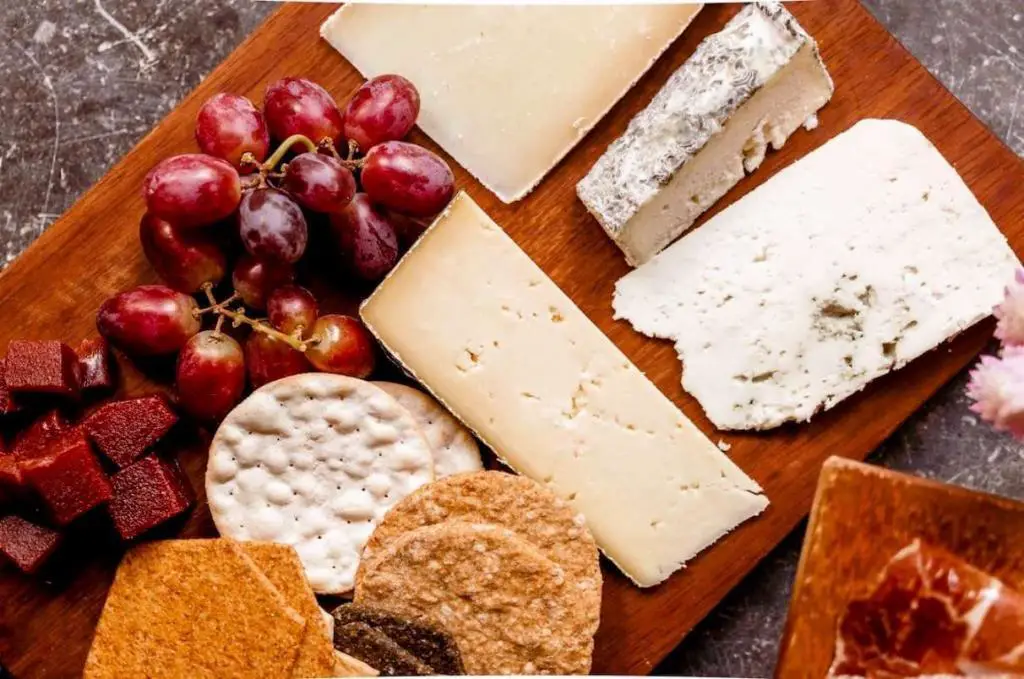A well-crafted charcuterie board is like a work of art. It’s a beautiful display of colors, textures, and flavors that come together to create something special. And just like any work of art, it deserves to be enjoyed with the perfect wine pairing. But picking the right wine can seem daunting, especially if you’re not an expert in the intimidating field that is wine and pairing. But never fear! We’re here to help.
Your Next Wine and Cheese Pairings
Read on for our top tips on how to pick the perfect wine to pair with your next charcuterie creation, fashioning your next culinary masterpiece coupled with the best liquid companions at your disposal.
Picking Your Ingredients
The first step is to choose the right cheese. A good rule of thumb is to include a variety of cheese types on your board, ranging from soft and creamy to hard and crumbly. For softer cheeses like brie or Camembert, look for wines with lower acidity levels, so as not to overwhelm the delicate flavor of the cheese. For sharper, more pungent cheeses like bleu cheese or aged cheddar, go for a wine with higher acidity to balance out the strong flavor.
Next up, consider the meats you’ll be including on your board (if you’re adding a meat element). Salami, prosciutto, and other cured meats pair well with red wines like cabernet sauvignon or merlot, while white meats like chicken or turkey are best paired with white wines like chardonnay (a buttery edge) or Pinot Grigio (more of an acidic pop). If you’re including seafood on your charcuterie board, champagne or sparkling wine is always a safe bet. Common seafood layers on a charcuterie board involve smoked salmon, oysters, and caviar which all go well with the Champagne or Prosecco.
Finally, don’t forget about the other elements on your board! Fruits, vegetables, nuts, and spreads can all impact what type of wine you’ll want to serve. For sweeter toppings like honey or jams, going for a dryer wine to balance out the sweetness and sugar levels can go a long way in balancing your board overall.
If you’re serving savory toppings like olives or tapenades, look for a wine with higher sugar content to help balance out the acidity and brininess that can accompany ingredients with very little residual sugar.
Pairing Wine & Cheese: The Basics
There are a few basic guidelines you should follow when pairing wine and cheese. First, consider the weight of the cheese. Heavier cheeses like cheddar or gouda will pair well with red wines, while lighter cheeses like mozzarella or goat cheese go better with white wines. You’ll also want to take into account the strength of the cheese; strong cheeses can easily overwhelm a weaker wine, so look for something with a little more body to it. Finally, think about the flavors of the cheese itself. Is it salty? Sweet? Nutty? Fruity? Be sure to pick a wine that will complement those flavors rather than compete with them.

Classic Wine and Cheese Combinations
Let’s take a look at some classic combinations that are sure to please any crowd. A good place to start is with a classic red wine like Cabernet Sauvignon or Merlot and pair it with a sharp cheddar cheese. You can also pair these heavier wines with cheeses like Gruyere or Gouda, both sharper and bolder options.
For something a little lighter, try a Pinot Noir with a goat cheese or brie. Pinot Noir would also be great with a pepper jack or a cheese with spiciness in its build, as the fruity notes with a dry finish will complement each other quite nicely. Pinots tend to be finished in stainless steel (rather than spending time in oak barrels) so spicy cheeses are a good opportunity to pair with this particular varietal.
Chardonnay is always a safe bet when it comes to white wines, and it pairs well with just about any type of cheese – from sharper varieties like Parmesan or Gruyere to creamier ones like Havarti or Camembert. This is because most Chardonnays spend time in oak, and the grape has a reputation for having a “buttery” texture and viscosity, making it a great option when pairing with food. The texture will help to coat the palate and prepare it for the next bite, while the flavors will enhance (rather than compete with) the cheese.
If you’re looking for something a little outside the box, why not try a sparkling wine like Prosecco or Champagne with your charcuterie board? The bubbles add an extra element of fun and can help cleanse your palate between different types of cheese. They’re also great for cutting through rich, creamy cheeses like brie or blue cheese. Just be careful not to pair them with anything too sweet – the sugar in the wine can quickly become overwhelming.
Other Considerations
In addition to the type of cheese, there are a few other things you’ll want to keep in mind when pairing wine with your charcuterie board. The first is the other ingredients on the board. If you’re serving a variety of meats, fruits, and spreads, you’ll want to make sure the wine you choose can stand up to all of those different flavors. A good rule of thumb is to pick a wine that is as strong (or stronger) than the strongest flavor on the board.
You’ll also want to take into account the overall flavors of the board. Is it sweet? Salty? Spicy? Sour? You’ll want to pick a wine that will either complement those flavors or provide a nice contrast. For example, if you’re serving a board with a lot of sweet fruits and spreads, you might want to pick a wine with a little more acidity to balance things out.
Finally, don’t forget about the temperature of the wine. Red wines are typically served at room temperature, while white wines are usually served chilled. Sparkling wines can be served at either temperature, but most people prefer them slightly chilled. Lighter red wines that haven’t spent any time in oak also do very well with a slight chill on them. Keep this in mind when you’re planning your charcuterie board, as you’ll want to make sure the wine is the perfect temperature when your guests start to eat.
Now that we’ve looked at the general idea and some tips to remember when pairing cheese with wine, let’s take a look at a few specific combinations that will help you get the hang of pairing these two fantastic ingredients together for you and your guests:
Parmesan + Chianti Classico Riserva
This is a classic pairing for a reason – the sharpness of Parmesan cheese is perfectly offset by the bold, tannic flavors of a Chianti Classico Riserva. If you’re looking for a wine that will stand up to Parmesan’s pungent flavors, this is the way to go.

Manchego + Rioja Reserva
Manchego is a Spanish sheep’s milk cheese that has a robust flavor and firm texture. When paired with a Rioja Reserva, a Spanish red wine that is known for its complex flavors of ripe fruit and spice, the result is an explosion of flavor in your mouth. The Rioja brings out the nuttiness of the Manchego while tempering its saltiness – it’s a match made in heaven!
Gouda + Sauvignon Blanc
Gouda is a versatile cheese that can be enjoyed in many different ways. When paired with Sauvignon Blanc, however, it really shines. The acidity of the Sauvignon Blanc cuts through the richness of the Gouda and brings out its sweetness. This is an ideal pairing if you’re looking for something on the lighter side.
Prosciutto + Pinot Noir
Prosciutto is an incredibly flavorful cured meat that pairs well with many different types of wines. However, our favorite match is with Pinot Noir. The fruity flavors of Pinot Noir complement the salty goodness of prosciutto perfectly – it’s sure to be a hit with your guests!
Gorgonzola + Barolo
Gorgonzola is an Italian blue cheese that ranges in intensity from mild to sharp. When paired with Barolo—a rich and full-bodied Italian red wine—the result is an explosion of flavor that is sure to please any charcuterie lover.
Camembert + Pinot Noir
Camembert is a French cow’s milk cheese that is soft and creamy in texture. Its mellow flavor pairs perfectly with Pinot Noir, a light-bodied red wine that is known for its delicate fruit flavors.
It’s Not Rocket Science
There you have it – a few of our favorite wine pairings for charcuterie boards! Whether you’re planning an intimate gathering or a large soiree, these combos are sure to please. Picking the perfect wine pairing for your charcuterie board doesn’t have to be rocket science, but by following these simple tips, you’ll be sure to impress your guests with a selection of wines that complement your beautiful creation perfectly. So next time you’re putting together a spread, don’t forget about the wine – it could be just what you need to take your charcuterie game up a notch! So what are you waiting for? Grab a glass and enjoy!
A few unconventional wines to add to the mix to impress and education your guests – a bonus selection I’ve had great success with pairing these wines with all types of cheeses!
Did you know that a Lambrusco would pair perfectly with charcuterie? This Italian sparkling red wine is fruity and light, making it a great match for cured meats and cheeses. There is a broad spectrum of sweetness levels, so take that into account as you shop around for different options. If you’re looking to add something a little different to your charcuterie board, give Lambrusco a try!
Looking for something truly unique? How about a Chenin Blanc from South Africa? I’ve always loved this region for wine as they’re known for combining a slight sweetness with spicy, black pepper notes. This white wine is known for its honeyed flavor, which pairs perfectly with rich and creamy cheeses. If you’re feeling adventurous, give it a go!
Not all wines have to be serious – sometimes, the best ones are just meant to be fun! A Moscato d’Asti from Italy is a perfect example. This sparkling white wine is sweet and refreshing, making it a great pairing for fruit-based charcuterie boards. If you’re looking to add a touch of sweetness to your spread, Moscato d’Asti is the way to go. Not to mention, it can be a great “dessert-like” option to combine with your board. I’ve always loved surprising my dry drinkers with sweeter wines that they normally wouldn’t like, but learn to love through pairing correctly with the right foods.
Another good option for unconventional wine pairings is a German Riesling. I often recommend this to people who are new to wine because it’s incredibly versatile. It can range from sweet to dry, so there’s sure to be an option that appeals to everyone. Riesling is a great choice for those who are looking to add a little acidity to their board. It pairs well with most types of cheese, but I particularly love it with a soft cheese like Brie.
There you have it – a handful of unconventional but delicious wines to pair with your next charcuterie board! So go ahead and experiment, and don’t be afraid to try something new. Your guests will thank you for it. Happy sipping!
Food stylist & founder of One Board Gal. Known for creative food tips and simple cheese board inspiration. I am dedicated to helping you bring a lot to the table by sharing tricks, tips, and education for your next gathering.

